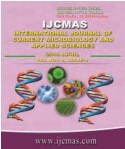


 National Academy of Agricultural Sciences (NAAS)
National Academy of Agricultural Sciences (NAAS)

|
PRINT ISSN : 2319-7692
Online ISSN : 2319-7706 Issues : 12 per year Publisher : Excellent Publishers Email : editorijcmas@gmail.com / submit@ijcmas.com Editor-in-chief: Dr.M.Prakash Index Copernicus ICV 2018: 95.39 NAAS RATING 2020: 5.38 |
To study the various fungi causing otomycosis with its isolation and identification of species from the clinical laboratory of Vijayanagara Institute of Medical Sciences, Ballari, ear swab samples are collected from the department of ENT which are suspected for fungal cause of otomycosis. KOH mount was done for the presence of fungal elements and also Grams staining of the sample is done to look for uniformly stained Gram positive fungal elements. Another ear swab from the same ear is directly streaked on the SDA slant for fungal culture. The tubes are incubated at 37 degree Celsius for 1month. Intermittently the tubes are checked for fungal growth. A total of 60 samples were collected from January 2018 to June 2018 from suspected cases of otomycosis in Department of ENT. Maximum cases were isolated from age group between 11y-20y with higher incidence among males-42 cases (70%).45 cases are positive for KOH, 48cases were positive for fungal culture. The isolates are as follows: A. niger (33.3%), A. flavus (31.6%), A. terreus (3.3%), others (11.2%) and no growth were (20%) From the above study, 11y-20y constitute the higher incidence of fungal infection in ear with male preponderance and the most common fungi isolated in otomycosis were A. niger followed by A. flavus. Early detection and treatment of otomycosis helps in preventing the invasion of infection further. Timely instillation of antifungal eardrops will help subsiding the infection.
 |
 |
 |
 |
 |